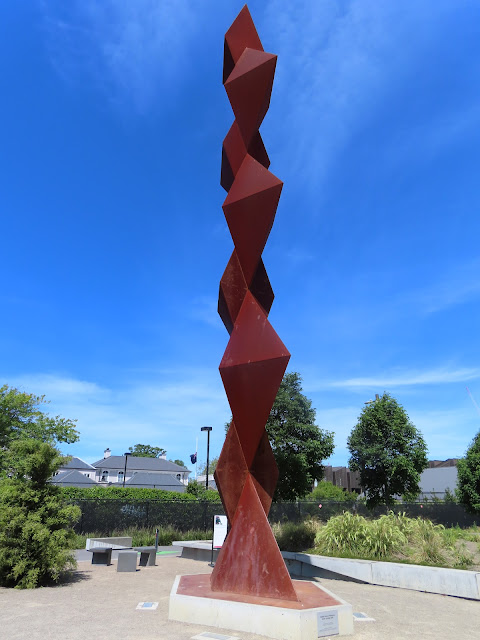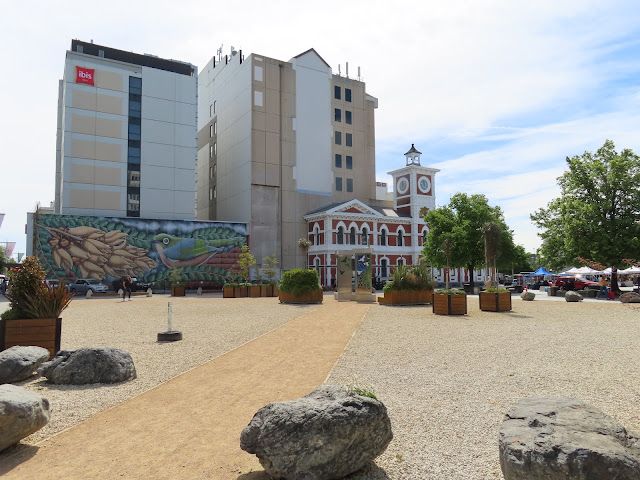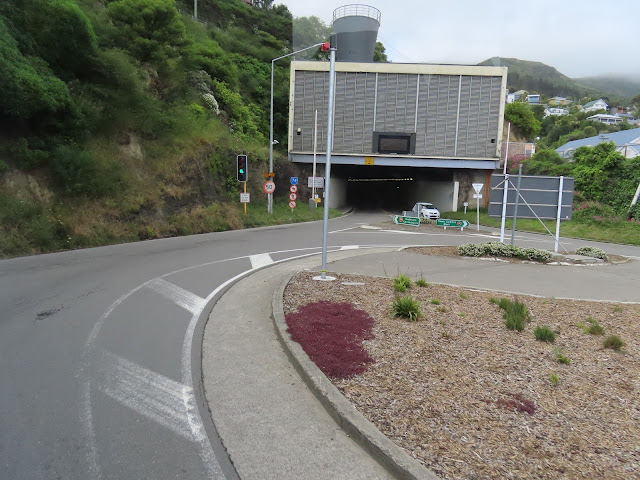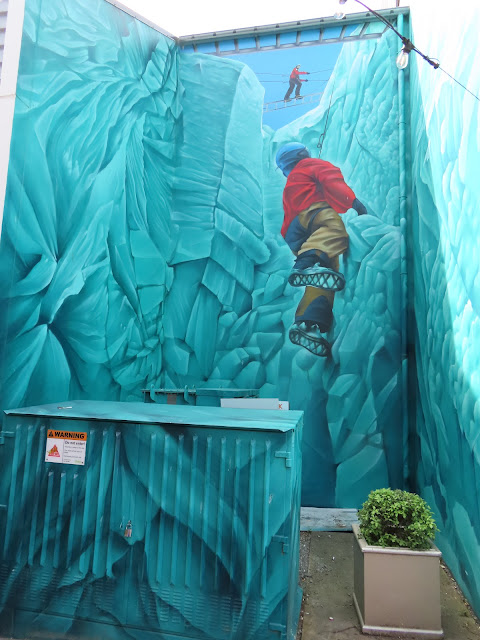Friday, November 17, 2023
Comments on the Comments
A Wee Bit O’ Scotland - November 18
We left Christchurch on our coach and headed south.to Dunedin. We had several interesting stops along the way to break up the long road trip and stretch our legs. We drove past a lot of farmland, with mountain ranges in the background. Sometimes we could see the sea, and it was a gorgeous aqua color.
The Maori name for New Zealand is Aotearoa. It means “the land of the long white cloud.” So, of course, I was always looking for long white clouds. I don’t know if this is the right kind of cloud:
We stopped in a small town called Geraldine. It was cute, well manicured, and rather Victorian. Geraldine had several shops and lunch spots, including a gourmet cheese shop: |
| The local beer is Emerson’s |
The stately Railroad Station:
Dunedin has a very proud Scottish heritage. On a street corner, a small replica of a famous church spire in Edinburgh, Scotland.
We also talked about education and health in New Zealand. Obesity is a problem. Fresh fruit, vegetables, and meat are expensive and people are turning to fast food. University is three years, not four.
Today’s fabric is the official tartan of Dunedin, New Zealand.
Thursday, November 16, 2023
Feeling Sheepish - November 17
Today is a National Holiday celebrating the Canterbury Region, which includes Christchurch. Maybe it’s a Regional Holiday. It’s hard to tell. Many things are closed, and there is a 15% surcharge at restaurants because they have to pay people more to work on the holiday. It is also a sort of Black Friday here, even though they don’t have Thanksgiving. I have also heard that Black Friday is next week.
When we got on the bus, Gavin passed out some local treats for us to sample. I really liked the Tim Tams, a cookie. (They say “biscuit” here.)
As our bus left Christchurch we headed into an area of beautiful rolling green hills. There were lots of sheep and cows. I tried to take notes while the bus was rolling along. Please excuse any errors or omissions on my part.
Against this pastoral background, Gavin discussed environmental issues. New Zealand is responsible for 0.09% of the world’s emissions - mostly from agriculture. Gasoline is heavily taxed. They pay the equivalent of US $12/gallon here. In some areas there is a 25% tax on top of fuel prices, There is a pickup truck tax. A proposed farmer’s tax is unfair, in Gavin’s opinion. There is a rebate for low emission vehicles. And so on. I sensed that Gavin’s information is filtered through a sieve deigned to fit his opinions, and should be taken with a grain of salt.
When we arrived at Rubicon Valley Farm, our host, Chris, joined our bus at the gate and talked while we drove in to the woolshed area. Chris is a very large retired cop. He is an excellent presenter and he gave us a quick, no nonsense orientation to the farm and the Shearing Show we would be seeing shortly.
- If you something is going to hurt you, it probably will. Don’t touch it.
- There’s a fence with a yellow sign on it. If you’d like to let me know if it is still electrified, please touch it.
First, we visited a pair of winsome alpacas. Obviously not New Zealand natives, but then neither are sheep or cows. Chris gave a short explanation of why he has alpacas on his farm. It boiled down to this: they are good-natured and easy to care for, and they yield nice wool. He trained the white one to come up and put his face on your shoulder when you put your arm around the black one.
Next, Chris introduced us to his dogs and explained their characteristics. He had two “eye dogs” that were mostly Border Collies, and one dog of a breed called Huntaway. Then Chris demonstrated how he uses the dogs to herd sheep. This was fascinating. |
| The sheep are at the far end of the fireld, but they see our group and they seem to know something is up. This was taken with a zoom lens. We are not really that close. |
Once Chris had picked out a sheep to shear, we all went inside the woolshed and Chris walked us through the process. He showed us the clippers, and explained each step of the shearing process. He talked about shearing competitions and how much time it would take an expert to catch and shear a herd. Because this was essentially a private tour for our OAT group, everybody had a good seat in the front and those who wanted to could try to clip off a bit of wool with the manual shears, which were like big scissors. The wool collected from these sheep was going to be used for carpets, Chris informed us.

One of Gavin’s friends, and another OAT guide who lives in Christchurch, invited our whole group over for a babecue tonight. His name was Kevin. He and his wife provided a lavish spread, consisting of lamb, sausages, chicken, green salad, cole slaw, Hokey Pokey ice cream, and a succulent Pavlova. Their home was beautiful. Kevin is a professional photographer, and his photos were in evidence all over the house. They were spectacular. We all chipped in for the dinner, but it was so generous and welcoming of Kevin and his wife to pull it all together. It turned out to be a rainy, chilly night, so the plan to sit outside fell through, but it was still really special. Kiwi hospitality!
Today’s fabric is 100% New Zealand Wool.
It is a New Zealand Wool Throw - Harland Heather|100% Wool, by Polly McGuckin, Exquisite Wool Traders.
Shabbat shalom!
Wednesday, November 15, 2023
Island Hopping - November 16
New Zealand has two main islands - the North Island and the South Island - and several hundred smaller islands. Although the South Island is larger, around 75% of the population lives on the North Island. The North Island and South Island are separated by 14 miles of rough water, known as Cook Strait. (Yes, that’s the same Captain Cook who visited Alaska and Hawaii.) Cook Strait can be crossed by ferry, or by air, as we did. We flew by turbo-prop from Rotorua’s tiny airport to the more substantial airport serving Christchurch, and thus commenced the South Island portion of our tour.
We arrived at our hotel around 2:00 pm, hungry, tired, and thirsty. Alas, our rooms were not ready, so we had to go on a walk with Gavin without first getting a few moments in our rooms to collect ourselves and prepare, as we had been expecting. For example, I needed to unpack our sunscreen, the map of Christchurch Gavin had given us, and other miscellaneous items, in order to feel ready to spend an hour or two walking around. Most of all I wanted a drink of water. Because we flew, I had dumped out my water in Rotorua. We had to leave our unlocked carry-on bag and backpacks, as well as our checked bags in a big pile in the lobby. As usual, I had packed my iPad and other electronics in the carry-on, as well as my medications, and I did not feel very good about just leaving them.
Gavin said we could stop somewhere to buy water, but after 15 minutes of walking we had not had a a chance to do so. Ken ran across a street and bought some for me. Five minutes later, Gavin showed up with a case of water from a grocery store. He had thoughtfully brought water for all of us, while leaving us to look around in a little square. I wish he had told us. I had gotten so dehydrated from the 2-hour flight, plus the waiting in the airport that I was feeling very cranky by that point.
Christchurch is the second largest city in New Zealand, at about 400,000. In 2011 Christchurch suffered a devastating earthquake. The quake killed 185 people and the damage to structures was widespread.
 |
| One of the monuments marking the 2011 Earthquake |
The iconic Christchurch cathedral was severely damaged. It was torn down and is now being rebuilt. A transitional cathedral, known as the Cardboard Cathedral, serves as a temporary place of worship.
 |
| The Cardboard Cathedral |
There are still vacant lots downtown, thanks to the earthquake. But there are some new buildings and a cute little area where a maze of alleyways lead to restaurants, shops, and a bustling market.
 |
| A temporary park on a vacant lot where there was once a downtown building |
 |
| This defiant clock tower has not succumbed to earthquakes. The building used to be the Chief Post Office. |
 |
| The Isaac Theatre Royal is named for philanthropist Diana, Lady Isaac. It was restored after the earthquake and remains a popular venue for performing arts. |
 |
| The hop-on-hop-off tram system offers several loops. We didn’t have time to take a ride, but it looked like fun. |
There are a number of beautiful murals and lots of public art. Many of the pieces of art seem to suggest brokenness or shattering.
 |
| This is a little hard to see. It is a gold-colored sculpture balanced on four wires. If you stand in the right spot, it will look like the spire of the fallen Christchurch Cathedral. |
The streets and sidewalks of the CBD emptied out pretty quickly after 5:00 pm. We walked back for dinner, thinking we’d try one of the inviting restaurants there. We tried a few, but we were told over and over that we had to have a reservation. It was very disappointing. We finally wandered back to the market where there is a small food court. We ate Nepalese dumplings. They seemed very similar to Chinese and Korean dumplings we have eaten.
 |
| Inside the market |
Today’s fabric is Prism II Granite 883, by James Dunlop for James Dunlop Textiles.
Tuesday, November 14, 2023
A Walk in Jurassic Park - November 15
Waimangu Volcanic Valley
We took an “optional tour” to Waimangu Volcanic Valley. An “optional tour” is not included in the fee paid to OAT for the basic tour package - there is an additional charge. We signed up for this morning’s optional tour. So did our entire group. At the end of the day, I felt very satisfied that we received good value for the extra payment. It was a phenomenal tour. We got to go to Jurassic Park, in a manner of speaking. We got to see how the world began. We got to see unbelievable bubbling mud pools and geothermal geysers, and “smoking” steam vents.
Ken took so many photos - and videos! I can’t begin to show all of them, or even half of them. But I will try to show a few as I tell the story of this one-of-a-kind day.
^ ^ ^ ^ ^ ^ ^ ^ ^ ^ ^ ^ ^ ^ ^ ^ ^ ^ ^ ^ ^ ^ ^ ^ ^ ^ ^ ^
We were dropped off at a small lodge in a lush jungle. Our guide, John, met our bus and introduced us to Waimangu Volcanic Valley. He took us to an overlook just past the edge of the parking lot where a stunning panorama suddenly came into view. A valley. A lake. Steam rising from a multitude of vents and from the surface of the lake. Giant fern trees.
 |
| Our first sight of the valley |
 |
| John |
Then, John invoked Aerosmith and Run DMC, and he said “Walk this way . . .”
And we followed him down a trail toward that fuming hellscape.
We stopped periodically at overlooks, and each time John explained a bit of the history of this valley. Before 1886, the valley was known for hot springs and pink and white terraces, created by mineral deposits accumulating over centuries. People came to the valley to marvel at the terraces, and some would even bathe in the hot springs.
On the far side of the valley a destructive giant lay sleeping. In 1886, Mount Tarawera erupted with an unimaginable ferocity. Mud and ash shot up, and then poured down. The valley was buried. The famous pink and white terraces were buried. Seven small Maori villages were buried. 105 people lost their lives. An area of about 15,000 square Km was covered with mud up to 40 meters deep.
When we reached the shore of Frying Pan Lake, we could smell the strong sulphuric vapors. John told us the waters and surrounding muds could be scalding hot and were dangerously acidic. There was a dead zone around the lake where nothing grew.
 |
| Steam rises from vents and from the surface of the lake |
 |
| Discoloration from algae |
 |
| Minerals and strange algae discolor the water near the shore |
Here are three very short, fun videos (6, 8, and 10 seconds) of some of the crazy geothermal activity.
We hiked to nearby Lake Rotomahana, where the water was not so dangerous. On the way, we passed bubbling mud and squirting geysers. At Lake Rotomahana we took a 45-minute cruise around the lake to get a close look at various points of interest that could not be reached by land. There were quite a few black swans here, but also geysers and steam vents. John Piloted the boat.
 |
| Black swans and cygnets |
Then we were driven back up to the lodge on a bus, driven by John. Our lunch was waiting for us at the cafe at the lodge. John helped serve it. John helped clean up. Wow. He was a terrific guide, and all these other things, too.
Waiotapu Mud Pools
On the way back, we stopped at a place called Waiotapu Mud Pools. It was so interesting. It was hard to tear yourself away.
Rotorua Walk
Later, Gavin led us on a walk through the center of Roturua. At this point I should mention that there are steam vents and other seismic oddities all over the city. The smell of sulfur is quite pervasive, depending on the wind.
Rotorua has clearly declined, but it has some lovely buildings and parks downtown. Our hotel, the Distinction Rotorua, was not much. I don’t think there are any nice or new hotels in Rotorua. The city was used as a national quarantine center when Covid struck New Zealand. After the pandemic, some of the vacant hotels were used to house homeless people. I don’t know whether that is what kept the hotels going, or whether it contributed to the sad decline of a city that was once famous for its spas and resorts.
 |
| The Klamath Falls Rose Garden connects Rotorua to its Sister City in Oregon |
 |
| This stately building was once the Rotorua Museum. It is now being restored but its future purpose is uncertain. |
 |
| A pleasant boardwalk defines the waterfront |
 |
| More black swans |
Home-hosted Dinner
As wonderful as the Waimangu Valley was, the most awesome part of our day lay ahead. One of the special things that happens on an OAT tour is the chance to attend a home-hosted dinner. We were told that usually the tour members are split up and sent to different homes in twos or fours. The tour leader never participates. It is our chance to interact with the hosts. This time, however, the hosts wanted all 16 of us to come to one family’s home.
We appreciated the opportunity to experience Maori hospitality in a family’s home. We did not feel comfortable taking photos, or even asking for permission to do so, so you will not see any photos here.
I wasn’t sure what to expect. Who would have enough space for 16 of us? What would a Maori home be like?
The answer to the second question is that it was just like a typical Anchorage home. It was in a nice neighborhood. It was modern and comfortable inside. The answer to the first question is a couple in their late 30’s named Aroha and Darrin. They have three daughters. Aroha is a health and PE teacher at a Maori immersion school in Rotorua. Aroha was recruited to play D1 basketball in the US and she is grateful for the opportunities that flowed from that experience. Darrin drove a logging truck for many years, but quit that job two weeks ago because of the terrible hours, which were not good for his family life. He just got a new job as a teacher’s aide at a high school, where he also hopes to be a role model for boys.
They speak Maori at home, but the children learn Maori and English at school. I don’t think Aroha and Darrin grew up speaking Maori at home, so this must be a challenge for them. Someone asked them about their tattoos. They both have tattoos that illustrate their lineage, but neither of them had facial tattoos. The family has home-hosted dinners two or three times per week!
We had a typical dinner of barbecued chicken, lamb burgers, sausages, kumara (sweet potato), cole slaw, and green salad. For dessert we had Hokey Pokey ice cream and pavlova.
After dinner, Aroha and Darrin sang a couple of Maori songs for us, and then performed an awesome haka. Then they showed us a video of students from Aroha’s school performing in a haka competition. We also had time to talk about the challenges facing the Maori community. Much of it sounded very similar to the kinds of things we hear about in Alaska.
Everyone in our group was completely blown away by this experience. This family is so full of passion and energy. Wonderful Maori hospitality!
Today’s fabric is Roar - Dinosaur Volcano (Cream), by Dashwood Studio.











































